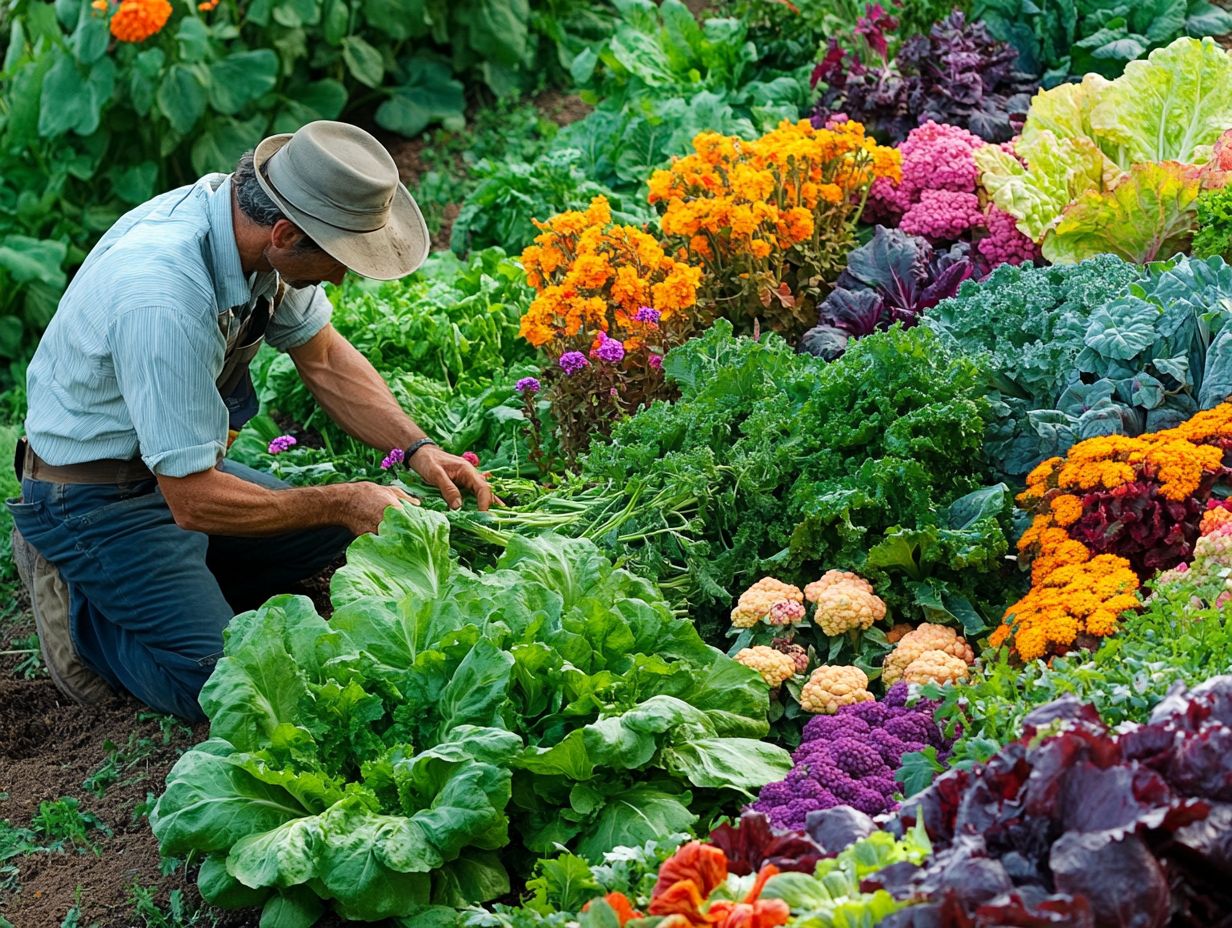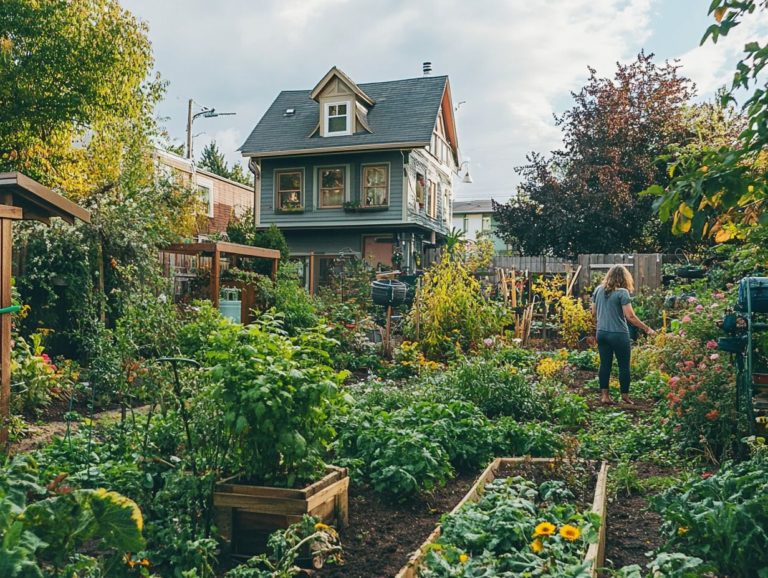What Are the Benefits of No-Dig Gardening?
No-Dig gardening is becoming popular among eco-conscious gardeners who want sustainable methods to nurture their plants. Techniques like crop rotation and raised beds play a vital role in this approach.
This method minimizes soil disturbance and offers numerous advantages, including environmental benefits, health perks, and improved soil health, especially for seasonal vegetables.
If you re excited to start your own no-dig garden, a comprehensive step-by-step guide is available to set you on the right path. Common misconceptions will be debunked, and troubleshooting tips will be provided to help you manage challenges like pests and weeds.
Dive in and discover the transformative power of no-dig gardening!
Contents
- Health Benefits
- How to Start a No-Dig Garden
- Common Misconceptions about No-Dig Gardening
- Troubleshooting in No-Dig Gardening
- Frequently Asked Questions
- What Are the Benefits of No-Dig Gardening?
- 1. What impact does no-dig gardening have on soil health?
- 2. How does no-dig gardening save time and effort?
- 3. What are the environmental benefits of no-dig gardening?
- 4. How does no-dig gardening benefit plant growth?
- 5. Can no-dig gardening improve the quality of produce?
- 6. What are the long-term effects of no-dig gardening?
Key Takeaways:

No-dig gardening eliminates the need for tilling and digging, promoting a healthier soil ecosystem.
This method helps the environment by reducing soil erosion and increasing biodiversity, while also improving health benefits for both the garden and the gardener.
Starting a no-dig garden is simple and can be done in just a few steps, making it accessible for beginners. It also dispels common misconceptions and helps troubleshoot any issues that may arise.
What is No-Dig Gardening?
No-Dig Gardening, popularized by Charles Dowding, enhances soil health without the hassle of traditional tilling, making it ideal for creating an organic vegetable plot. Instead of digging, you layer compost mulch over the soil surface, nurturing healthy plants and significantly reducing the need for weed control.
By preserving the soil structure and promoting beneficial organisms like a type of fungus that helps plants grow, you create a vibrant ecosystem perfect for cultivating organic vegetables such as sweet peas and asparagus.
This method isn t just a trend; it has deep historical roots in ancient agricultural practices that recognized the importance of effective soil management long before modern farming. It champions techniques like composting and layering organic materials, allowing nutrients to enrich the soil naturally over time.
The no-dig approach minimizes soil erosion and runoff, enhances biodiversity, and retains water.
Adopting this innovative strategy leads to healthier crops and supports long-term sustainability. It s an exceptional choice for gardeners committed to organic practices and eco-friendly solutions.
Advantages of No-Dig Gardening
The benefits of No-Dig Gardening are impressive, enhancing both environmental sustainability and crop production.
By prioritizing soil health through minimal disturbance, this gardening method reduces reliance on artificial fertilizers and herbicides. This approach allows you to grow organic vegetables efficiently while being respectful to the environment.
Embracing No-Dig Gardening represents a conscious choice for your garden and the planet.
Environmental Benefits
The environmental benefits of No-Dig Gardening are significant, mainly due to its focus on preserving soil health and increasing organic matter content. For those interested in enhancing their gardening practices, understanding the benefits of permaculture gardening can further nurture beneficial soil organisms and create a balanced environment that supports plant growth.
This ecological gardening practice protects existing soil structures and plays a crucial role in soil conservation, ensuring that nutrients remain available for future generations. By minimizing tillage, No-Dig Gardening significantly reduces carbon footprints; less disturbance means less carbon is released into the atmosphere.
Adding layers of organic matter and compost enriches the soil, enhancing its ability to support various plant species and fostering greater biodiversity. This harmonious relationship between plants and soil organisms cultivates robust ecosystems, resulting in healthier crops and resilient gardens that thrive sustainably.
Ready to transform your garden? Start your no-dig journey today!
Health Benefits

No-Dig Gardening isn t just a trend. It s a transformative practice that benefits both the environment and your health by growing healthy vegetables packed with nutrients.
This method helps your plants thrive while preserving essential soil organisms, including mycorrhizal fungi, which help plants absorb nutrients from the soil.
By steering clear of soil disturbance, you maintain the delicate ecosystem beneath the surface. This allows beneficial microorganisms to thrive. Applying compost mulch is crucial. It provides a protective layer that nourishes your plants while suppressing weeds and retaining moisture.
As you nurture your garden, you ll find yourself rewarded with vibrant produce and significant long-term health benefits. Consuming organic vegetables, often free from harmful pesticides and chemicals, enhances your nutrition and supports a balanced diet.
Therefore, embracing No-Dig methods not only cultivates a thriving environment for your plants but also enriches your life.
How to Start a No-Dig Garden
Embarking on a No-Dig Garden journey involves a series of straightforward steps that prioritize soil health and efficient garden maintenance.
You’ll need to grasp essential layering techniques, incorporating materials like compost mulch and cardboard mulch.
By doing so, you can cultivate a flourishing vegetable garden without disturbing the delicate soil structure.
Step-by-Step Guide
A step-by-step guide to No-Dig Gardening begins with understanding the essential techniques and tools you’ll need for a successful experience.
First, choose a suitable location for your vegetable plot, ensuring it gets plenty of sunlight and is easily accessible for watering and harvesting.
Once you’ve selected your spot, clear the area of any weeds or debris. You can do this without traditional digging by laying down cardboard or newspaper to smother any existing plants.
Next, layer organic materials like straw, grass clippings, and compost on top to create your garden bed. This method not only saves you time but also enhances soil health.
After that, plan your planting strategy, keeping crop rotation in mind each season to boost nutrient cycling and reduce pest problems.
Regular watering and mulching will support your plants health while keeping weeds at bay, ensuring your No-Dig garden thrives.
Common Misconceptions about No-Dig Gardening
Common misconceptions about No-Dig Gardening often arise from misunderstandings surrounding its principles and practices. Misconceptions include:
- Skipping tilling leads to poor weed management.
- No-Dig results in poor soil quality.
However, this innovative gardening technique actually fosters healthy soil organisms and cultivates a well-balanced ecosystem, enhancing the overall vitality of your garden.
Debunking Myths

Debunking myths about No-Dig Gardening is essential for you to fully grasp its benefits. One prevalent misconception is that No-Dig leads to an increase in weed seeds, when, in fact, this method fosters soil health and encourages beneficial organisms that keep those pesky weeds at bay.
You might assume that skipping conventional tilling results in poor soil quality, but that overlooks how No-Dig practices actually enrich the soil. They preserve its structure, enhance moisture retention, and promote a diverse microbial community.
Research has demonstrated that healthy soil serves as a natural barrier against weed proliferation. A balanced ecosystem competes effectively with weeds. With No-Dig Gardening, organic matter accumulates naturally, boosting fertility without resorting to chemical fertilizers.
By understanding these nuanced truths, you can truly appreciate the holistic advantages of adopting No-Dig techniques.
Troubleshooting in No-Dig Gardening
Troubleshooting in No-Dig Gardening requires you to identify common challenges and implement effective solutions to sustain a flourishing garden.
You may find yourself grappling with issues like weed suppression and nutrient deficiencies, but rest assured, these obstacles can typically be managed with well-informed gardening tips and techniques.
Embracing this knowledge will empower you to cultivate a vibrant, healthy garden with confidence.
Start your No-Dig Garden today and reap the amazing benefits for your health and the environment!
Common Issues and Solutions
Identifying common issues in No-Dig Gardening is essential for a productive vegetable garden. One frequent challenge is managing pests without harmful chemicals. This can be solved with safe methods to control pests.
Maintaining optimal soil health is key. Over time, nutrient depletion can occur without traditional tilling. Regular layers of organic mulch not only suppress weeds but also enrich the soil as they break down.
Keep an eye on seasonal changes that impact plant growth. Adjusting planting times based on frost dates and selecting seasonal crops for your climate can enhance your garden’s productivity.
By adopting these practices, you’ll conquer common challenges and enjoy a thriving, sustainable garden year after year.
Frequently Asked Questions
What Are the Benefits of No-Dig Gardening?

No-Dig gardening, popularized by Charles Dowding, minimizes soil disturbance and uses organic matter to create healthy conditions. Here are six key benefits:
1. What impact does no-dig gardening have on soil health?
No-dig gardening maintains soil structure and vitality by protecting beneficial microorganisms and earthworms. It encourages a diverse range of microorganisms, improving fertility and nutrient availability.
2. How does no-dig gardening save time and effort?
By avoiding heavy digging and tilling, no-dig gardening reduces labor and time. This allows more focus on other tasks like planting and harvesting.
3. What are the environmental benefits of no-dig gardening?
No-dig gardening reduces soil erosion and water runoff, promoting sustainable practices. It also cuts the need for chemical fertilizers and pesticides.
4. How does no-dig gardening benefit plant growth?
This method creates a nutrient-rich environment for plants. It helps retain moisture, making it ideal for drought-prone areas.
5. Can no-dig gardening improve the quality of produce?
Yes, it provides a healthier growing environment for plants, leading to higher yields and better-tasting produce.
6. What are the long-term effects of no-dig gardening?
No-dig gardening benefits your garden over time. It preserves soil structure and nutrients, leading to sustained yields and improved soil quality.






